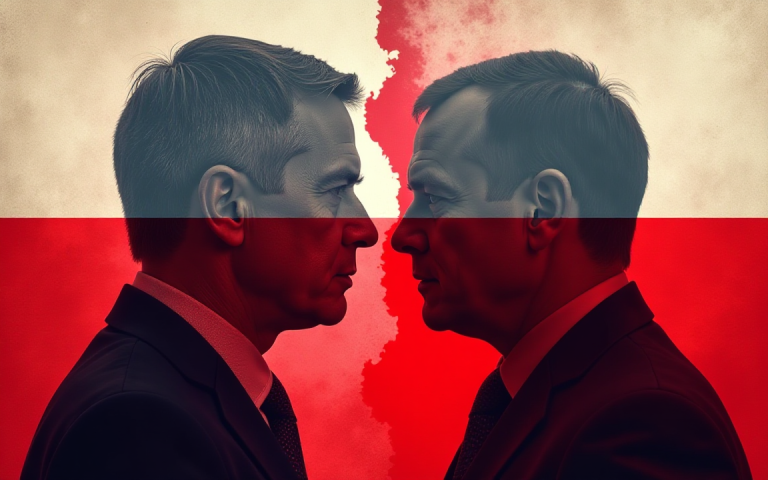Poland elections are set to conclude this Sunday in a presidential runoff that’s too close to call.
Pro-EU centrist Rafał Trzaskowski and right-wing nationalist Karol Nawrocki are locked in a statistical tie, with undecided voters expected to tip the balance.
It’s not just about who becomes president. The result will decide whether Poland backs liberal reform and closer EU ties or doubles down on nationalism and conservative politics.
Both sides are treating this like the final round of a culture war. And both believe the future of the country is on the line.
Who are the two men fighting for power?
Rafał Trzaskowski is the 53-year-old Mayor of Warsaw and a veteran of Civic Platform, the party of Prime Minister Donald Tusk. He lost the 2020 presidential race by just over two points.
This year, he’s back with strong urban support, a modernizing message, and the backing of every party in the ruling coalition.
At 53, he’s well-known, polished, and multilingual. He presents himself as a safe pair of hands in a volatile region.
His record in Warsaw includes infrastructure upgrades, expanded public transport, and visible LGBTQ+ support, though critics call him overly academic and detached from everyday struggles.
Karol Nawrocki could not be more different. At 42, Karol is a former boxer and historian who leads Poland’s Institute of National Remembrance.
He has no political track record but was chosen by the opposition Law and Justice party (PiS) to bring fresh energy to the nationalist right. He presents himself as a man of tradition, faith, and order.
Trzaskowski speaks to Poland’s cities and Europe-facing middle class. Nawrocki connects with the rural majority, the culturally conservative, and those who feel left behind.
Why this vote matters more than usual
The Polish presidency is not ceremonial. The president holds veto power over legislation, controls key foreign policy decisions, and can block judicial reform.
Outgoing President Andrzej Duda used those powers to block nearly every major reform from Tusk’s coalition since it took office in 2023.
The result: Poland’s ruling parties have the numbers but not the freedom to govern.
If Trzaskowski wins, he removes the final barrier to progressive reforms including judicial restructuring, legal access to abortion, and civil unions for same-sex couples.
If Nawrocki wins, he holds the line for the nationalist right and reopens the door for a PiS comeback in 2027.
In short, the outcome will either cement Poland’s pro-EU path or stall it for another term, if not disrupt it forever.
What do the numbers tell us?
The numbers point to a dead heat.
Trzaskowski won the first round on May 18 with 31.36%, slightly ahead of Nawrocki’s 29.54%.
Since then, all major polls have shown the race tightening.
An IBRIS poll published on May 25 had Trzaskowski at 50.4% and Nawrocki at 49.6%, with nearly 9% undecided.
But raw vote totals from the first round reveal a deeper story.
Far-right candidates like Sławomir Mentzen and Grzegorz Braun took a combined 21%. Their base, young and anti-establishment, now holds the balance of power.
Both candidates know it. And both have tried to win them over.
Can Mentzen’s voters swing the result?
Sławomir Mentzen came third in the first round with almost 15% of the vote, most of it from men under 30. His voters don’t trust PiS or Civic Platform.
They want low taxes, strong borders, and to keep the EU at arm’s length.
Mentzen released an eight-point policy pledge and invited both finalists onto his YouTube channel.
Nawrocki signed it live on air. Trzaskowski refused, but gave what many described as a masterclass in composure and policy depth.
Then came a video of the two men having beers together after the interview, alongside Foreign Minister Radosław Sikorski.
The far right accused Trzaskowski of betrayal. But millions watched the conversation. It’s unclear who benefitted more.
Mentzen doesn’t want to be king. He wants to be the kingmaker.
Foreign influence, ad scandals and political noise
The campaign hasn’t been clean. Republicans in the US Congress accused the EU of supporting Trzaskowski through double standards and silence.
Donald Trump met with Nawrocki in the Oval Office and told him he would win. Former Trump allies campaigned for him at a CPAC conference held in Poland.
Meanwhile, Poland’s cybersecurity agency confirmed foreign-funded Facebook ads that favored Trzaskowski and attacked Nawrocki, but could not identify the source.
PiS says the money came from Democrats in the US. Trzaskowski denied involvement and threatened legal action.
None of this has moved the polls. But it’s fueled a sense that bigger players are circling Poland’s election and that the stakes are no longer just national.
What the rallies revealed
On May 25, both campaigns held simultaneous rallies in Warsaw just streets apart.
Trzaskowski’s “March of Patriots” brought out as many as 500,000 people, according to his campaign.
It was backed by the full ruling coalition and featured a speech by Romania’s president-elect Nicușor Dan, who promised closer ties inside the EU.
Nawrocki’s “March for Poland” pulled around 50,000, led by PiS chairman Jarosław Kaczyński.
He promised a secure, strong Poland rooted in Christian identity, and cast himself as a voice for the forgotten.
The images from Warsaw made one thing clear: Poland isn’t divided in two. It’s split in half.
So who will win?
No one knows. And that is rare in Polish politics. The country is split between two models of identity, power, and belonging.
Trzaskowski has the cities, the moderates, and much of the ruling coalition behind him.
Nawrocki has the rural vote, PiS’s machine, and a large share of the far-right electorate. The youth vote could tip the result. Or not show up at all.
What’s certain is that both men have peaked at the same time. Neither holds a decisive edge. All that’s left now is the count.
The post Poland’s June 1 election hangs in the balance: what’s at stake appeared first on Invezz

